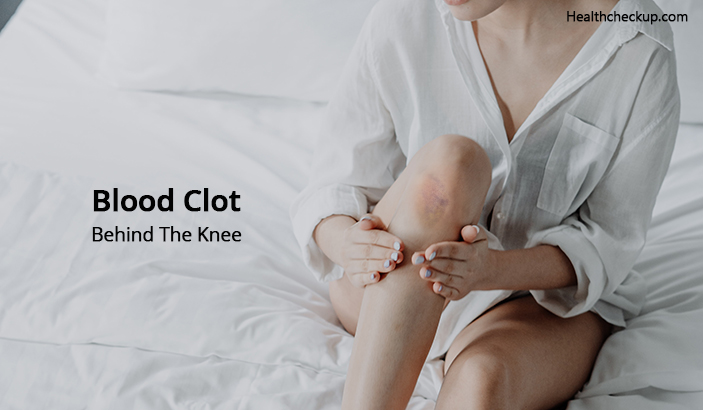A blood clot behind the knee indicates a kind of venous thromboembolism and is a serious situation that may lead to life risk conditions like a pulmonary embolism.
Blood Clot Behind Knee-Overview
The popliteal vein is present behind the knee and it runs behind the knee helping in transportation of blood back to the heart and if there’s a blood clot in this vein it is referred to as popliteal vein thrombosis.
Popliteal vein thrombosis happens when there’s poor circulation of blood, blood vessel damage, or due to an external injury. It is associated with pain, redness, and swelling in the knee and leg region.
What Is Popliteal Vein Thrombosis?
The popliteal vein is a vein that runs back of the knee and is one of many blood vessels that carries blood from the leg into the lower vena cava-a large vein for carrying blood from the body’s lower parts to the heart.
When a blood clot develops in this vein it is called popliteal vein thrombosis or in layman language blood clot in the knee cap. This clot is a kind of venous thromboembolism (VTE) also known as deep vein thrombosis (DVT). It’s a bit dangerous and at times opens up and passes via the heart to lungs. A thrombus that passes to the lungs is called a pulmonary embolism (PE).
What Are The Symptoms Of A Blood Clot Behind The Knee?
The symptoms of a blood clot behind the knee or that instance any kind of VTE in legs include;
- Redness in calf area or knee
- Swelling in leg or knee
- A warm region in the leg or behind the knee
- Pain in leg or knee, usually like that of a cramp
When To Worry About Blood Clot Behind The Knee?
Usually, if you suspect having a blood clot or go through the above symptoms it’s a worry and you should consult a doctor without delay. It is necessary to seek medical attention immediately if you have the below symptoms besides a clot;
- Breathing shortness
- Chest pain
- Coughing with blood
What Causes Blood Clot Behind The Knee?
Sometimes, there’s no clear reason for a blood clot behind knee, however, different factors can heighten the chances of its development. In a word, anything that affects or lowers blood flow in the knee area increases the risk of a knee blood clot. When there’s no proper blood circulation, blood pools in the vein leading to clot.
Common factors that can lower the flow of blood include;
- A long period of sitting or standing
- Immobile or bedridden
- Obesity
- Smoking
- Pregnancy
[Also Read: Causes of blood clots in pregnancy]
Medical factors that increase blood clotting include;
- Few types of cancers
- Damaged hip or leg
- Spinal cord damage
- Heart ailments
- Varicose veins
- Past VTE
- Past VTE history in the family
- Genetic conditions like thrombophilia, sickle cell anemia, and antiphospholipid syndrome
Can You Get A Blood Clot Behind Your Knee?
The answer is tricky and yes maybe you can get if you have the risk factors and are undergoing the above medical complications. Maybe, you may not get it too.
In addition to the above, damage to veins in the knee especially due to surgery or major leg injury can lead to it. Birth control pills, hormone replacement therapy, and other estrogen filled medicines also increase the risk factors.
Increasing age is also a major base for this and the risk of VTE doubles every 10 years once you reach 40.
Can A Blood Clot Cause Pain Behind Knee?
Yes, a person with this ailment will have pain associated with redness and swelling in the knee region, and the same may be present all through the leg also based on the severity.
How To Diagnose Blood Clot Behind Knee?
The diagnosis of a blood clot behind the knee requires a physical examination of the knee and leg in addition to noticing the heart rate. An examination of medical history is done to check for potential risk factors. Besides below tests are conducted;
- Ultrasound
- CT scan
- D-dimer test
- Rheumatological conditions
- Heart failure
- Cancer
- Inflammation
How Do You Treat A Blood Clot Behind Knee?
Many treatment options are available such as;
- Anticoagulants such as heparin, warfarin, rivaroxaban, dabigatran and apixaban
- Vena cava filters, these are suggested when a person can’t take anticoagulant medicines
- Thrombolytic therapy
- Compression stockings
How To Prevent Blood Clot Behind Knee?
- Losing additional weight or having correct BMI
- Wearing compression stockings
- Regular exercising
- A short walk for every 1–2 hours
- Staying hydrated
- Flexing the feet or changing positions very often
- Avoiding crossed legs
Besides, avoiding smoking is very much needed to stop the blood clot behind the knee.

Sudheendra is a passionate blogger for 8 years and holds a Degree in Journalism & Mass Communications. His writings particularly focus on health, medicine, diet & lifestyle. For him, everything that interlinks and relates to health & medical world entices him. His write-ups aim at educating people not by just giving facts but by infusing human touch.









